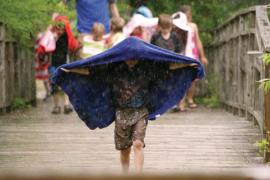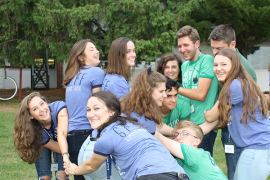A primary challenge for any business is recruiting and maintaining customers. In 2012, 27.2 percent of camps surveyed reported camper enrollment that was lower or at its lowest point compared to the previous five years (American Camp Association, 2013). While 59.7 percent of surveyed camps developed budgets expecting to operate below capacity in 2012 (American Camp Association, 2013), 31.7 percent reported that their enrollment was still less than 90 percent of their target. In short, many camps continue to fall below their enrollment goals, and understanding what predicts camper enroll¬ment remains an important challenge.
Camper enrollment in any given year is the combination of previous campers retained plus new campers added. The American Camp Association measures camper enrollment annually through camp director surveys, and researchers have dissected these data to highlight industry-wide enrollment trends (Bialeschki, 2006; Bialeschki & Malinowski, 2009). While useful, these summaries are largely descriptive and do not identify specific predictors of enrollment.
For the present study, three camp outcomes were identified that are related to camper enrollment: retention, word-of-mouth marketing, and satisfaction. Retention is important because returning customers represent increased profit (Keaveney, 1995), and 79.4 percent of camps indicated that over half of their campers were returning customers (American Camp Association, 2013). New customers are also vital, and word-of-mouth marketing is important in increasing new business (Reichheld & Markey, 2011). Furthermore, camps are thought to rely heavily on customer recommendations (Cony, 1998; Hedrick, Dick, & Homan, 2007; Rich & Harrolle, 2012). As McDougall and Levesque (2000) point out, satisfaction is a necessary, but not sufficient, condition for retention. This logic applies to word-of-mouth marketing in that parents must at least be satisfied with the camp to recommend it to others. Such reasoning makes sense to measure satisfaction separately from retention and word-of-mouth marketing.
Predictors of these three outcomes (i.e., retention, word-of-mouth marketing, and satisfaction) must be identified in order to guide camp enrollment practices. One study found that 95 percent of parents surveyed would recommend camp to a friend and would send their child back, though it was not clear which dimensions of the camp experience drove these motivations (Kelly & Harrolle, 2012). Other researchers have looked at parental assessments of specific aspects of camp (e.g., team building, sleeping facilities, canoeing, etc.) to identify key dimensions of camp programming (Hedrick et al., 2007). Extending this work, the present study examined parental perceptions of several dimensions of the camp experience (counselors, directors, facilities, safety, community, food, activities, and friends) as predictors of retention, word-of-mouth marketing, and satisfaction.
Method
Procedures
Five organizations participated, representing seven traditional residential summer camps (two all-boys, two all-girls, and three coeducational). “Traditional” was defined as a program in which campers, living together in small units, participate in a wide range of activities. Camps were recruited through online message boards. At the beginning of the summer, camper families received an e-mail explaining that their camp was participating in a study. Parents received a recruitment e-mail three to nine weeks after their child’s session ended and had one week to complete the online questionnaire.
Participants
Participants included 416 parents (53 percent female camper parents and 84 percent moms). Parents described them-selves as White (93.7 percent), Black/ African-American (3.1 percent), Hispanic or Latino (2.0 percent), Asian (< 1 percent), and Multiracial (< 1 percent). The sample was largely from middle- and upper-class households with 78.5 percent reporting an annual income of $75,000 or more.
Measures
Camp Dimensions. The researcher created the Camp Experience Dimensions Scale, which included eight subscales measuring parental levels of agreement with statements regarding counselors, directors, facilities, safety, community, food, activities, and friends. Each subscale contained seven items that were rated on 5-point scales with anchors 1 = Completely Disagree and 5 = Completely Agree. Participants were given the option to select Don’t Know, which was coded as missing data. Internal consistencies for each scale ranged from .92 to .98 (see Table 1).
Camp Outcomes. Three outcomes were measured: retention, satisfaction, and word-of-mouth marketing. Each outcome was measured with two items, rated on 9-point scales with anchors 1 = Completely Disagree and 9 = Completely Agree (see Table 2).
Analysis and Results
To examine which camp dimensions predicted the three camp outcomes, three multiple regressions were conducted. Additional variables were entered into the models to control for the potential effects of camper age, family income, weeks at camp, and summers attended. These analyses yielded a significant model for each outcome. Parents’ ratings of the camps’ activities, counselors, directors, and community predicted retention scores. Along with the covariates grade and family income, ratings of camp activities, directors, safety, and counselors predicted word-of-mouth marketing. Finally, ratings of camp activities, counselors, directors, food, and safety predicted overall satisfaction. See Tables 3, 4, and 5 for a summary of each model.
Implications
In the present study, dimensions of the camp experience were identified by parents as predictors of camp outcomes. The study’s design allowed for a better understanding of which dimensions were related to camper retention, word-of-mouth marketing, and overall satisfaction. These findings are relevant for directors when determining where to invest resources.
Consistent Predictors
Parents’ perceptions of camp activities, counselors, and directors were significant predictors of all three camp outcomes. These three predictors may constitute a cluster of particularly important camp dimensions. Activity scores were the strongest predictor in each model, indicating that investing resources in improving activity instruction and equipment may be a good first step for underperforming camps. In practice, improving activities through enhanced training should increase counselor and director quality.
Safety Matters
Safety ratings significantly predicted two of the outcomes: word-of-mouth marketing and satisfaction. Camps often emphasize safety as a recruitment tool, but these findings suggest that making camp safety salient for current parents is also important (see ACA, 2011a).
Unique Predictors
Campers’ grade level was positively associated with word-of-mouth marketing. Parents of older campers were more likely to recommend their camp to others than parents of younger campers. If parents of younger children are hesitant to recom¬mend a camp, it may compound existing difficulties in recruiting this age group (Cohen & Veinstein, 2009). Interestingly, data from the 2012 Camper Enrollment Survey, which polled residential and day camps, seem to suggest younger campers are not especially difficult to recruit (ACA, 2013). Both the present study and Cohen and Veinstein only examined residential camps, which may explain the differences in the data. These results indicate that resident camps should consider camper age when identifying reasons for lagging word-of-mouth marketing.
Limitations
First, none of the dimension-outcomes relationships described are causal. Second, most of the parents were white, middle- and upper-class mothers, making it difficult to generalize the findings to minority or low-income parents. Additionally, work remains in fully understanding what contributes to enrollment-related outcomes, and future research would benefit from using multiple informants (i.e., parents, counselors, campers, and leadership staff).
Conclusion
The present study offers relevant infor¬mation for camp leadership teams. Most notably, the findings provide an initial road map for understanding what contributes to camper reten¬tion, satisfaction, and word-of-mouth marketing based on parent perceptions. For example, if a camp is struggling with retention rates, a good starting point is to examine activities, counselors, directors, and camp community. If word-of-mouth marketing is lagging, directors should review counselors, directors, safety, and activities. Every camp will differ in terms of what may need to change in each area, and directors will have to engage various stakeholders in defining specific challenges. The findings in this study, though, provide a place to begin.
In identifying eight dimensions of the camp experience, future research can pinpoint relationships involving each dimension. At the camper level of analysis, researchers could examine which dimensions predict youth developmental outcomes such as responsibility, independence, and friendship skills (American Camp Association, 2011b). At the camp level of analysis, camp dimensions could be analyzed as predictors of year-to-year revenue changes or actual retention.
Author’s Note: I would like to thank the following organizations and personnel who helped make this research possible. Thank you for being a part of this process and for being dedicated to furthering our understanding of the summer camp industry: YMCA of Delaware — Camp Tockwogh, Maryland — Bryan Wallace and Alex Flaxenburg; Camp Speers- Eljabar YMCA, Pennsylvania — Cherie Hammond; Merrimack Valley YMCA — Camp Lawrence and Camp Nokomis, New Hampshire — Tim Chatfield and Claudia Soo Hoo; Camp Choconut, Pennsylvania — Fred Lorber and Billy Table; Van Buren Youth Camp, Michigan — Jason Groth.
References
American Camp Association. (2013). Fall 2012 camper enrollment survey. Retrieved from www.ACAcamps.org/research/improve/enrollment-recruitment-survey
American Camp Association. (2011a). The healthy camp study impact report: Promoting health and wellness among youth and staff through a systematic surveillance process in day and resident camps. Retrieved from www.ACAcamps.org/sites/default/files/images/education/HealthyCampStudyImpactReport.pdf
American Camp Association. (2011b). Camp youth outcomes battery: Measuring developmental outcomes in youth programs (2nd ed.). Retrieved from www.ACAcamps.org/research/youth-outcomes-battery
Bialeschki, M. D. (2006). What’s happening with camp enrollment? Camping Magazine, 79(2). Retrieved from www.ACAcamps.org/campmag/0603bialeschki
Bialeschki, M. D. & Malinowski, J. (2009). Camper enrollment: Time to hold a steady course. Camping Magazine, 82(2). Retrieved from www.ACAcamps.org/campmag/issues/0903/camper-enrollment
Cohen, S. M., & Veinstein, J. (2009). Jewish overnight camps: A study of the greater Toronto area market. Retrieved from www.jewishcamp.org/sites/default/files/u5/NEW%20Toronto_Research_Study.pdf
Cony, S. (1998). Marketing matters: Expert testimony. Camping Magazine, 71(3). Retrieved from www.ACAcamps.org/content/marketing-matters-expert-testimony
Hedrick, J., Dick, J., & Homan, G. (2007). 4-H camp marketing survey. Presented at the 2007 American Camp Association Camp Research Symposium. Retrieved from www.ACAcamps.org/research/connect/07symposium
Keaveney, S. M. (1995). Customer switching behavior in service industries: An exploratory study. Journal of Marketing, 59(3), 71-82.
Kelly, K., & Harrolle, M. (2012). Parent perceptions of the benefit of camp. Presented at the 2012 American Camp Association Camp Research Symposium. Retrieved from www.ACAcamps.org/sites/default/files/images/research/symposium/ACA-Research-Abstracts-2012-Final.pdf
McDougall, G. H. G., & Levesque, T. (2000). Customer satisfaction with services: Putting perceived value into the equation. The Journal of Services Marketing, 14(5), 392-410.
Reichheld, F. & Markey, R. (2011). The ultimate question 2.0: How net promoter score companies thrive in a customer-driven world. Boston, MA: Harvard Business Review Press.
Rich, S., & Harrolle, M. (2012). Communicating the positive impacts of camps: Marketing implications. Presented at the 2012 American Camp Association Camp Research Symposium. Retrieved from www.ACAcamps.org/sites/default/files/images/research/symposium/ACA-Research-Abstracts-2012-Final.pdf
Matt is a doctoral student studying human development at the University of Maryland. He earned his master’s in experimental psychology from Saint Joseph’s University and has eleven years of camp experience. Contact: barstead@umd.edu.
Originally published in the 2013 November/December Camping Magazine



